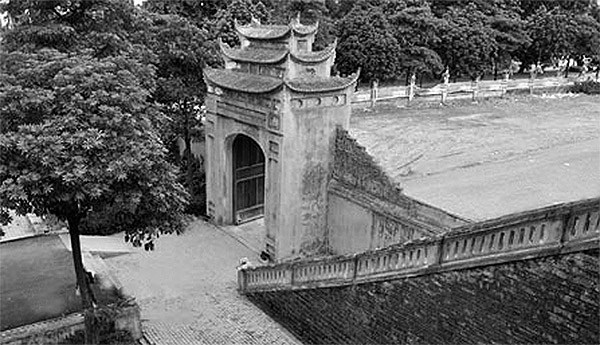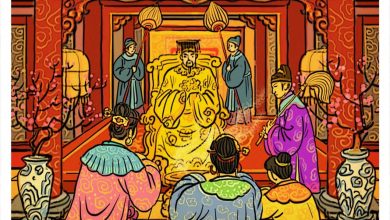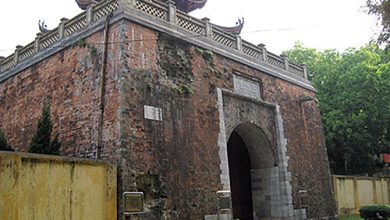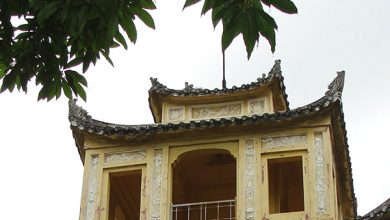The rise and fall of Tong Binh before Thang Long time
Before becoming an “eternal capital”, marked with the year of 1010 when King Ly Cong Uan promulgated the edit on moving the Capital to Thang Long, Hanoi was a prosperous land, playing an important role and once had been selected to set up the central citadel of the country.
Under Kings Hung Vuong’s country foundation era (about the 6th – 7th century BC), Hanoi belonged to Bộ (an administrative level equivalent to a province) Giao Chi, one of 15 Bộ of Van Lang State. Bộ Giao Chi included Hanoi, Hung Yen, Nam Dinh and Ninh Binh at the present. At that time, Hanoians focused on the banks of To Lich River. This place was called Bon Do or Long Do Commune or To Lich Village. This was a place with “rolling dragon, squatting tiger” position which later was chosen to become the capital by King Ly Cong Uan.
According to old documents, To Lich River ran through the village to Cai River (Red River). They erected a bamboo bridge over To Lich River and named it Giat Bridge (around Cua Bac Street now). At that time Long Do Commune included a number of old hamlet such as Rung Hamlet (Lam Ap), Gia La Hamlet, Rung Nga Hamlet (Nha Lam), Bai Hamlet (Binh Sa), Trai Ca Tuoi Hamlet (Tien Ngu).
The Head of this Commune was To Lich. The To Lich was not rich but generous; they respected filial piety and often helped others. Later, when To Lich passed away, Long Do people bestowed him the god of the village and renamed Long Do to To Lich Village. The shrine of To Lich Village or Long Do Village was built on Nung Mountain located opposite to Giat Bridge, which was considered a sacred mountain of the area. Therefore, later the people still consider To Lich as the mountain god, river god and the god of Thang Long – Hanoi also.
To King An Duong Vuong, the capital of our country was moved from Bach Hac (Phu Tho today) to Co Loa (in Soc Son, Hanoi now), To Lich village remained in the same peaceful place.
In 207, Trieu Da invaded our country. Due to underestimating the enemy, An Duong Vuong failed, starting the darkest chapter in national history – a thousand years under Northern domination. To Lich Village is no exception, also under the rule of the Northern empire for a thousand years.
Under the Han domination, Hanoi belonged to Tay Vu and Phong Khe Districts. To the Wu and Tan domination, Ha Noi belonged to Vu An and Nam Dinh Districts. To Hieu Vu De of the Luu Tong Dynasty, Hanoi was upgraded to a district, i.e. Tong Binh Urban District. Tong Binh Urban District was divided into three districts: Nghia Hoai, Tuy Linh and Xuong Quoc. The land was later chosen as Thang Long Imperial Citadel, along with Tu Liem and Hoai Duc Districts (in Nghia District and Tuy Linh Districts today).
In 544, after Ly Bi revolted against the yoke of the Northern domination, i.e. Liang Dynasty, he crowned himself emperor, took the title of South Viet Emperor (also known as Ly Nam De) built up ramparts of bamboo and timbers at the rivermouth of To Lich River. This was the first time, Hanoi built citadels and ramparts, becomng the political center of an independent state. Although the survival time was not long, but this was a heroic period of Thang Long – Hanoi in particular and Vietnam in general.
In 602, Ly Phat Tu, a descendant of Ly Nam De, surrendered to the Sui Dynasty. The Sui Dynasty divided the country into three districts i.e. Giao Chi (the North), Cuu Chan (Thanh Hoa Province) and Nhat Nam (Nghe Tinh) and set up Tong Binh as the metropolis of Annam colonial government. The Imperial City at that time became the headquarters of the Northern invaders during the Sui and Tang Dynasties.
However, during this time, the soldiers of the Sui and Tang Dynasties garrisoned at Tong Binh did not have a undisturbed life. The people constantly rose up against the invasion domination, such as the revolts of Ly Tu Tien, Dinh Kien and Mai Hac De (Mai Thuc Loan), doing much damage to the colonial army.
In 791, Phung Hung crushed military domination, liberated Tong Binh and set up the capital here, maintaining peace for seven years because he then was ill to death. People worship him as Bo Cai Dai Vuong (Great King). After Bo Cai Dai Vuong passed away, Tong Binh once again fell into the grip of northern feudal court.
In 801, Bui Thai colonial chief sent soldiers to repair Annam La Thanh Citadel, dig moats and bank more citadels. He combined Death Citadel and La Thanh Citadel to form a citadel to increase the power to fight against revolts of the residents. During this period, La Thanh was banked about 6.82 meters high. The citadel had three gates; on each gate, there was a gazebo. The Eastern and Western Gates with three spaces were called “Triple space gates”. The Southern Gate was the main entrance with five doors and five-space gazebos. In the citadel, there was 10 buildings, with 40-space to accommodate weapons buildings on both sides. Now, it was a relatively magnificent citadel.
However, Bui Thai could not hold out for long; in 803, Bui Thao was defeated by the people’s revolt under the leadership of General Viet Vuong Quy Nguyen and had to flee back to his country. Then, Ly Tuong Co was assigned to be the colonial chief in our country. Ly Tuong Co and all next colonial chiefs chose La Thanh and Tong Binh as the metropolis. In 819, Ly Tuong Co was killed by General Duong Thanh, his son Duong Chi Liet and his close friend Do Si Giao in an uprising. Han Uoc was the next colonial chief to be chased out of the country in 828. In 843, the country’s militants captured by the enemy had to work hard to build the citadel at Tong Binh. They rose up and drove Colonial Chief Vu Hon off the country. In 860, Colonial Chief Ly Ho also had to flee from the citadel back to his country because he could no longer hold out the uprising of the insurgents under the command of leader Do Thu Trung.
Since 863, Hanoi area had two buildings. The first citadel was Giao Chau (also called Giao Chi Citadel) as the metropolis of the colonial government, banked in 757 under Truong Ba Nghi’ rule. This citadel circumference was more than 6km; To Lich River in the north and Cai River (Red River today) in the east were natural moats. This was called La Thanh Citadel or Cuu Thanh (Old Citadel). Inside, there was Death Citadel with the circumference of 1.6 km. The second citadel was Kim Thanh, banked in 825 under Ly Nguyen Hy’s rule. Every year, the domination government forced the people to pay taxes to buy bamboo and timber and grew around the 12-miles citadel; outside, to grow thorny bamboo. This is why the citadel was called Lac Truc (Bamboo Citadel).
In 866, Cao Bien, the next colonial chief was sent to marshal Tong Binh, ordered to bank Dai La Citadel. To cut the good layer of earth, eliminate the impetus of our country, Cao Bien buried thousands of pounds of copper and iron to exorcise everywhere. But the magic tricks could not help him; he had to cry: “Oh! When will the impetus of South Country stop? Staying long here, I would incur calamity!” And to avoid the calamity, he sought to return to the North. After Cao Bien, Tang Con, Chu Toan Duc and Doc Co Ton were assigned to keep Dai La. However, all of them could not stay for long at Tong Binh.
Under Cao Bien’s rule, he rebanked Tong Binh and called the citadel Dai La. Dai La had two layers of walls. Outer wall was also a dam which was 6,337m long and 4.65 m high with the footing of 5.3 m wide. The inner wall was 5,947m long and 8.06 meters high with the footing of 7.75 meters wide; on each of the four wall sides, a small wall of 1.5 m height was built. On the walls, there were 55 watch-towers; five of them were built on the gates, the 6 side gates had revetment walls; there were 34 roads and 3 surrounding moats. The distance between the inner and outer walls was 50m. In the citadel, there were 5,000 houses for Tang army to stay.
In 905, Khuc Thua Du revolted and attacked Dai La Citadel, and then drove off the Tang military to their country, proclaimed himself the Commander in Chief. He was famous for saying: “From now on, the South Country belongs to the South Country Citizens”. Khuc Thua Du, his son Khuc Hao and his grandson Khuc Thua My set Dai La as the headquarters.
In 930, Khuc Thua My was defeated by the Nam Han Dynasty. Dai La Citadel was controlled by the enemy again.
In 931, Duong Dinh Nghe rose up and regained Dai La Citadel. After six years in power, Duong Dinh Nghe was assassinated by Kieu Cong Tien, causing the indignation among the people. Before the mutiny of the people, Kieu Cong Tien called for help from the Nam Han Dynasty. Right after that, the Nam Han sent troops to attack our country. Ngo Quyen, Duong Dinh Nghe’s son-in-law then gathered soldiers and killed Kieu Cong Tien to take revenge. Later, he arrayed the iron pile battlefield and defeated the Nam Han troops on Bach Dang River. After landslide victory on Bach Dang River, Ngo Quyen crowned himself to throne, opening up a long-term independence and sovereignty for our country.
The Ngo Dynasty reigned for 26 years, setting up the capital in Co Loa. Then, under the Dinh, Early Le Dynasties, the capital of the country was located in Hoa Lu (Ninh Binh), the homeland of Dinh Bo Linh which was convenient to defending the country. Dai La Citadel then became the prime citadel of Tong Binh, no longer the center of the country.
Thus, except for the time Ly Nam De claimed himself emperor on a par with the Chinese emperor, until the Ngo Dynsaty, although Viet Country gained independence many times, the leaders still claimed themselves as Commanders in Chief . Therefore, though chosen as the place to set up headquarterss several times, Dai La was not considered to be the capital as such.






